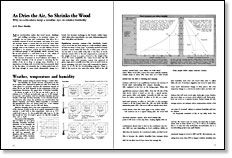As Dries the Air, So Shrinks the Wood
Why woodworkers keep a weather eye on relative humidity
Synopsis: Wood expert R. Bruce Hoadley says that assessing the humidity of the air in your shop or storage areas is as important as working with wood that has been properly dried in the first place. Moisture exchange in a board’s surface layer, which takes place immediately, can cause disheartening problems with glues and finishes. He explains how wood holds water and moisture content, as well as how relative humidity affects boards after being kiln-dried. He offers advice on controlling relative humidity and talks about his own shop’s limitations. Side information addresses weather, temperature, and humidity and how these ratios affect wood, and how to measure relative humidity.
Most woodworkers realize that wood moves, shrinking and swelling according to its moisture content. Accordingly, we use joints and constructions that allow for a moderate amount of wood movement, and many of us now use moisture meters to ensure that our wood has been dried to a safe level. But a one-time check of moisture content isn’t enough. Here in the northeast, you can take delivery of wood kiln-dried to 7% moisture content, but if you then store it in an unheated garage, it will gradually adsorb moisture from the air and increase to a new level of up to 14%, which, if unanticipated, would come as an unpleasant surprise.
The amount of moisture in wood balances and adjusts to the relative humidity of the air around it. Assessing the humidity of the air in shop or storage areas, therefore, is as important as working with wood that has been properly dried in the first place. An extremely dry or damp period may not last long enough to cause much dimensional change in a board, but moisture exchange in the board’s surface layer, which takes place immediately, can cause disheartening problems with glues and finishes.
Equilibrium moisture content— One sometimes comes across wood that has been sitting in a well-ventilated, unheated barn for thirty or forty years. It probably reached its lowest moisture content within the first two or three years, and it is not any drier or more stable today than it was then. In wood, moisture content (MC) is the ratio (expressed as a percent) of the weight of water in a piece of wood to the weight of the wood if it were completely dry. Green wood may start off with more than 100% moisture content (the sapwood of green sugar pine is actually more than twice as much water as wood, averaging 219% MC), but it will commonly be dried to about 7% to 9% MC for woodworking purposes. Water is held in the wood in two ways: free water, held in the cell cavities, and bound water, held within the cell walls themselves. When wood dries, it loses free water until the moisture content drops to about 30%; from then on it loses bound water. As the cells lose bound water they shrink, creating stresses that can lead to checking and warping.
From Fine Woodworking #39
For the full article, download the PDF below:
Fine Woodworking Recommended Products

Ridgid R4331 Planer

DeWalt 735X Planer

AnchorSeal Log and Lumber End-Grain Sealer





















Log in or create an account to post a comment.
Sign up Log in